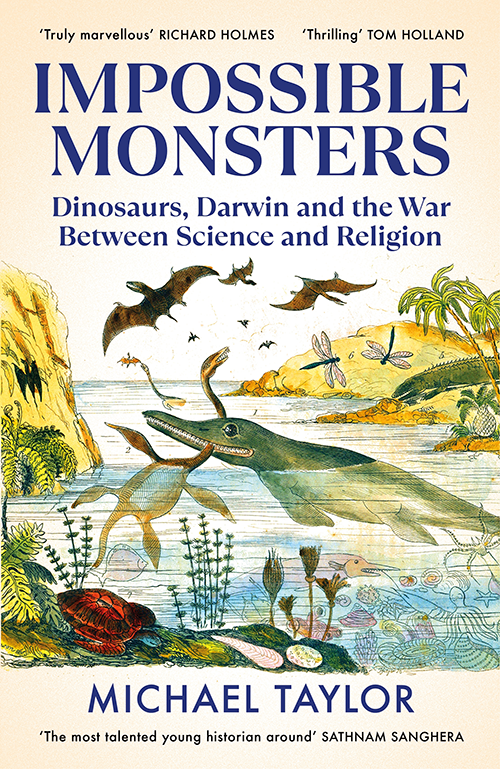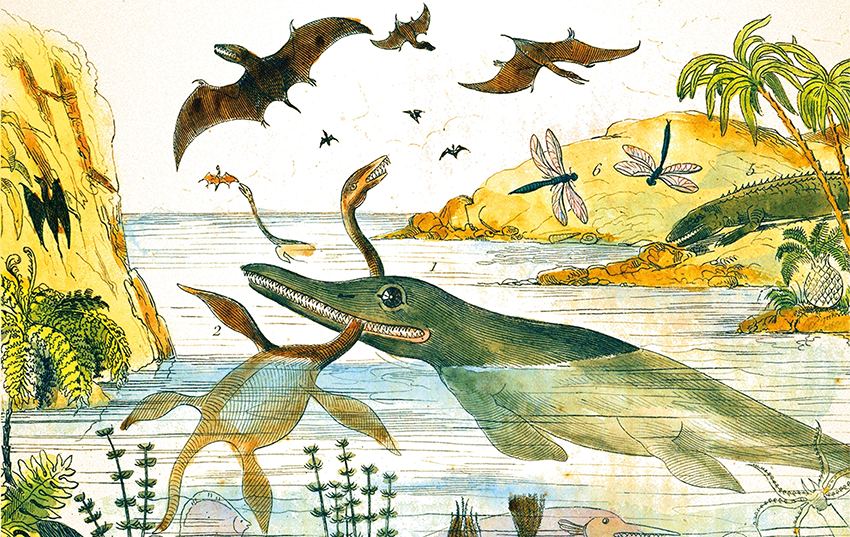Review: Impossible Monsters: Dinosaurs, Darwin and the War Between Science and Religion, Michael Taylor, Bodley Head
The image of science and religion at war was partially invented by the American historians John Draper and Andrew White in the late nineteenth century. They saw it as a conflict between a religious impulse to impede knowledge and the scientific advance of it. For them, Christianity was a ‘night’ that had settled over Europe for centuries, but science, springing from the Enlightenment, was, as the name suggests, finally, bringing in the light.
Modern atheists have promoted this image, but recent, more nuanced histories from the likes of Martin Rudwick and Nicholas Spencer have suggested that Draper and White glossed over the fact that most of the players involved in the advances in geology and palaeontology in the nineteenth century were believers, or deists at the very least, and the Christian conception of progress in history was crucial to driving scientific discovery, so the conflict thesis is overplayed. Michael Taylor’s book is a revision of these revisionist histories, arguing that while the history is not so stark, and there is some harmony, there is much evidence to suggest significant conflict.
Taylor’s book is about how the discovery of deep time and the dinosaurs in the nineteenth century changed society, unsettling previously solid religious beliefs. He concentrates on the main players, and he is terrific at summarising their biographies as he lays out how intellectual progress was linked to the personalities.

As significant as anyone was Mary Anning, who pulled fossils out of the southern cliffs of England, the Ichthyosaur among them. Her discoveries created two problems: naturalists and theologians pondered why God would let creatures go extinct and why their fossilised bones were found buried in rock. The first issue seems odd to us now perhaps but is linked to ideas about God’s perfect creation. (Some theorised that the creatures might still survive elsewhere on Earth.) The second issue seemed to confirm what others had been talking about already: that the Earth was older than suggested by the literal, 24-hour days of the Bible’s creation account.
French naturalist Georges Cuvier had argued that the ‘days’ of creation might be longer or metaphoric. But in the aftermath of the French Revolution and in the context of atheistic publishing this was controversial. William Buckland, devout believer and pioneer of palaeontology, found it hard to reconcile a geological timescale with the Bible in conservative Oxford. Conservative church authorities refused to concede ground, even as it shifted under them.
Another issue that came to dominate nineteenth century debate was the fixity (or not) of species, an issue famously linked to Charles Darwin, who was inspired not by dinosaurs but by the variations among living species. Cuvier, despite his other views, believed in the fixity of species, as did Buckland, who argued, for one, that the plesiosaur was so bizarre that only God could have designed it.
There were others, though, who were happy to reconcile belief in God and belief in evolution. The novelist Charles Kingsley described God starting the process and then letting natural selection do its thing. George Mantell, discoverer of the Iguanodon, knew that his discoveries undermined biblical literalism, but he saw this new world as further evidence of God’s wondrous works. Alfred Russell Wallace, co-discoverer of evolution, thought evolution needed direction from an ‘overruling intelligence’.
Taylor says his aim is not to adjudicate on belief but to concentrate on the story, so it’s something of a surprise when he lapses occasionally into the kind of language that animated Draper and White. He describes Wallace’s mention of ‘overruling intelligence’ as a repudiation of natural selection, but here Taylor conflates God and the notion of special creation. Evolution may have made for a reconsideration of biblical literalism, but it is not a substitute for God. Unfortunately, conservative nineteenth-century critics fell into the same trap of seeing evolution and religion as opposed, with one describing Darwin’s Descent of Man as reducing ethics to the level of bees or ants, perhaps missing the point that defenders of the new scientific theories usually argued they did not concern ethical questions.
Of course, conservative Anglicans were also worried about a demotion of humans from our special place in creation, which might then unsettle societal hierarchies. It is true that the Bible describes humans as made in God’s image, but Thomas Huxley said, sensibly, that the Bible also describes humans as having come from dirt, so why should we be offended at being described as related to the other apes?
Thomas Huxley is a key character in Taylor’s account. Taylor emphasises that Huxley, who coined the term ‘agnostic’ and was known as ‘Darwin’s bulldog’, became increasingly hostile to religious authorities and naturalists who argued against Darwinism. Nicholas Spencer paints a more ambiguous picture of Huxley’s views, suggesting that Huxley argued against narrow-mindedness in both theologians and scientists. As a scientist, he was sceptical of scientific proof of God, but was not uniformly anti-religious.

Taylor suggests, hyperbolically, that Darwin did away with God and that the Genesis account ‘lay in ruins’. What was ruined was merely a literal interpretation of it, even if some believers continue today to promote the notion that the Bible rules out evolutionary theory. In fact, all these developments helped to better understand just what type of book the Bible was and what it said about God’s nature. Some reviewers of Darwin’s Origin of Species praised it for revealing God’s methods. The matter of God’s existence is debatable, of course, but evolutionary theory was not the nail in God’s coffin. Deep time and the dinosaurs didn’t despatch the deity.
Nick Mattiske blogs on books at coburgreviewofbooks.wordpress.com and is the illustrator of Thoughts That Feel So Big.












